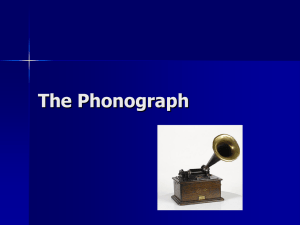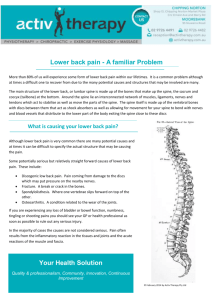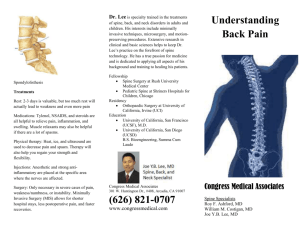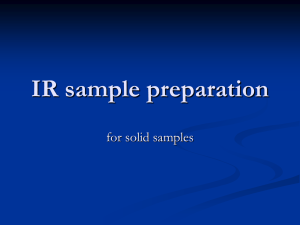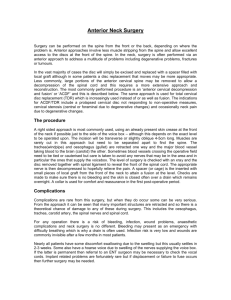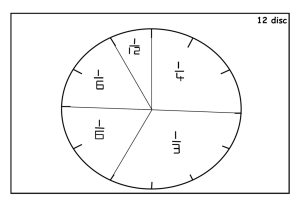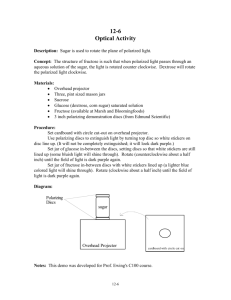LOW BACK PAIN Lower back pain is a very common symptom, and
advertisement
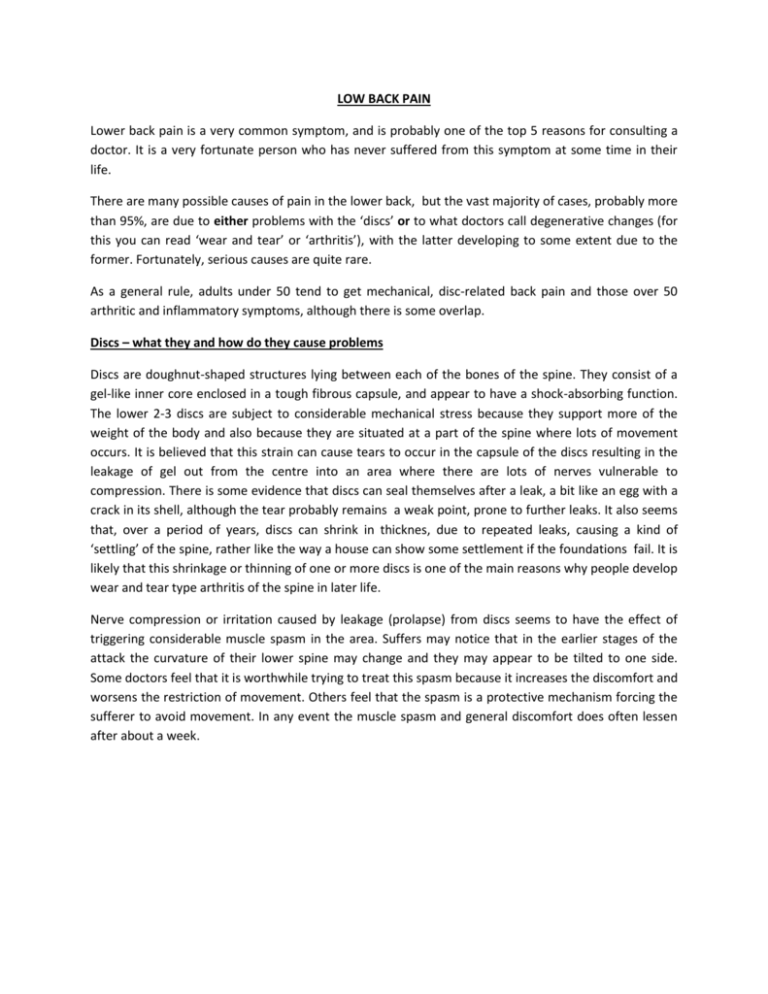
LOW BACK PAIN Lower back pain is a very common symptom, and is probably one of the top 5 reasons for consulting a doctor. It is a very fortunate person who has never suffered from this symptom at some time in their life. There are many possible causes of pain in the lower back, but the vast majority of cases, probably more than 95%, are due to either problems with the ‘discs’ or to what doctors call degenerative changes (for this you can read ‘wear and tear’ or ‘arthritis’), with the latter developing to some extent due to the former. Fortunately, serious causes are quite rare. As a general rule, adults under 50 tend to get mechanical, disc-related back pain and those over 50 arthritic and inflammatory symptoms, although there is some overlap. Discs – what they and how do they cause problems Discs are doughnut-shaped structures lying between each of the bones of the spine. They consist of a gel-like inner core enclosed in a tough fibrous capsule, and appear to have a shock-absorbing function. The lower 2-3 discs are subject to considerable mechanical stress because they support more of the weight of the body and also because they are situated at a part of the spine where lots of movement occurs. It is believed that this strain can cause tears to occur in the capsule of the discs resulting in the leakage of gel out from the centre into an area where there are lots of nerves vulnerable to compression. There is some evidence that discs can seal themselves after a leak, a bit like an egg with a crack in its shell, although the tear probably remains a weak point, prone to further leaks. It also seems that, over a period of years, discs can shrink in thicknes, due to repeated leaks, causing a kind of ‘settling’ of the spine, rather like the way a house can show some settlement if the foundations fail. It is likely that this shrinkage or thinning of one or more discs is one of the main reasons why people develop wear and tear type arthritis of the spine in later life. Nerve compression or irritation caused by leakage (prolapse) from discs seems to have the effect of triggering considerable muscle spasm in the area. Suffers may notice that in the earlier stages of the attack the curvature of their lower spine may change and they may appear to be tilted to one side. Some doctors feel that it is worthwhile trying to treat this spasm because it increases the discomfort and worsens the restriction of movement. Others feel that the spasm is a protective mechanism forcing the sufferer to avoid movement. In any event the muscle spasm and general discomfort does often lessen after about a week. Different age groups – different types of back pain Younger adults tend to suffer from sudden attacks of lower back pain of disc origin. These are the patients that hobble into the surgery saying that their ‘back has gone’ Many such patients begin to improve after 5-7 days and may be more or less fully- recovered within 2 weeks. There are exceptions and some have symptoms lasting for many weeks, necessitating further investigations. Because most of these episodes are due to disc injury, it is not unusual to have occasional recurrences, over a period of years, although in the longer term attacks tend to stop. It is likely that a significant proportion will go on to develop more arthritic-type symptoms in middle age and beyond, with back pain which is often of lower intensity but more persistent. People over the age of 50 are more inclined to suffer from lower back pain of wear and tear or arthritic origin. As described above, the level of discomfort may be quite a bit less than an acute attack but still troublesome and more persistent, perhaps with a degree of stiffness. Some people over the age of 75 suffer from osteoporosis (thinning of the bones) and can develop what is referred to as a compression fracture of one or more of their vertebral (spinal) bones. This is a form of stress fracture in a weakened bone and causes pain, sometimes quite severe, for several weeks before healing takes place. Women who are pregnant or who have recently had a baby seem to be prone to lower back pain. This is probably due to a combination of postural changes in pregnancy and hormonal effects causing instability of the joints of the pelvis. It must also be appreciated that mothers of young children also do lots of bending and lifting. Back pain in children and younger teenagers is a difficult area, medically, and usually needs investigating unless it is of short duration or due to an obvious recent non-serious injury. Treatment –what are the benefits The simple answer is probably less than might be expected. Medication is always an option and several types are prescribed: Pain-killers (analgesics) eg Paracetamol (with or without codeine), Codeine,Tramadol, Morphine Anti-inflammatories eg Ibuprofen (Brufen), Diclofenac (Voltarol) Muscle-relaxants Most back pain sufferers will want to take pain-killers and if the pain is quite severe it seems logical to use stronger medication. However, side-effects are common with strong analgesics, which tend to cause sedation or stomach upsets like nausea or constipation. Often it is necessary to compromise and use a medium strength analgesic which gives some level of relief but is also well-tolerated. Anti-inflammatories can be useful and can be combined with analgesics. They are not prone to cause sedation but can trigger indigestion or other gastric symptoms in certain people. For safety reasons, they are probably best given for short courses of a few weeks, but some people with arthritic-type back pain need to take them for longer. Muscle relaxants are of rather uncertain benefit but some patients with very acute low back pain are given Diazepam (Valium), occasionally by injection at A&E departments. The main problem is sedation and it is probably only worth considering in the very early stages of a disc-related episode if the discomfort is excruciating. An alternative, generally non-sedating medication called Methocarbamol is quite often prescribed (in tablet form), although it is not always very effective and there can be a few minor side-effects. Physiotherapy is often considered and tried for low back pain. The effectiveness is difficult to assess because physiotherapy tends to be given as a course of treatment over a few weeks and during that time many people would probably get better anyway. Private physiotherapists are usually keen to offer treatment but this can be expensive at around £30 per session for 6-8 sessions. Before embarking on physiotherapy it is worth considering that probably around 75% of people under 50 with acute back pain will be significantly better within 2 weeks and it is quite possible that physiotherapist sometimes take credit for ‘cures’ undeservedly. This will also apply to osteopaths and chiropractors and possibly to acupuncturists. However, it has to be acknowledged that lower back pain is often unpleasant and frustrating and results in restriction of normal activities. In these circumstances, it is not easy to do nothing and the psychological benefits of any intervention should not be underestimated. The problem with NHS physiotherapy is the waiting time between referral and start of treatment, usually several weeks. Again, it is difficult to know whether to refer or not, but a reasonable compromise would be to wait for 2 or possibly 3 weeks to see if there is any spontaneous improvement. Surgery really is a last resort in lower back pain and rarely, if ever, truly cures the underlying problem. Very occasionally, there is no alternative – typically when a large amount of material leaks (prolapses) from the centre of the disc and causes severe and persistent nerve compression. The patient will usually have had moderate to severe back pain, without any improvement, for more than 6 weeks , plus other symptoms like pain down one or more leg (sciatica), numbness or even weakness of a leg ,or problems with bladder or bowel symptoms. A MRI scan will have confirmed a substantial disc prolapsed. Surgery is nowadays carried out by either neurosurgeons or by spinal surgeons. The aim is to remove the displaced disc material and possibly fuse the joint if the disc is either badly damaged or there have been repeated attacks of severe symptoms. The results of surgery are mixed and long term outcomes vary. Patient satisfaction will depend on how bad the symptoms were before, compared with after, surgery. Spinal surgery is normally carried out under general anaesthesia, but several years ago microsurgery using a laser, carried out whilst the patient was awake, was popular with some surgeons. Unfortunately, the outcomes did not live up to expectations and this type of surgery now seems to have fallen out of favour. It must be said that surgery has little, if any, part to play in back pain in over 50s where the problems are predominantly degenerative (arthritic) Points to note It is rare for low back pain to have a serious cause Patience is a virtue – many cases improve spontaneously, particularly in the under 50s The information obtainable from X-rays is quite limited – an X-ray can be completely normal in someone with severe symptoms MRI scans are the one big advance in the field and can provide much more information as to the precise cause of low back pain. Unfortunately, they are expensive and in demand for more serious conditions making them effectively rationed as an NHS investigation and only requested if back symptoms are prolonged Treatment often doesn’t influence the outcome very much Some people do have to be prepared to live with a degree of back pain and accept that symptoms will sometimes recur Within reason, sufferers should try to keep active and positive in outlook, despite the symptoms When should back pain be taken more seriously? When it is associated with weakness or loss of feeling in one or both legs When it causes problems with bladder or bowel function When there are symptoms of infection such as high temperature, sweats and shivers When there is weight loss or a persistent feeling of general illness When the pain develops gradually and becomes steadily worse over a period of weeks When the pain appears soon after a bad fall or injury
